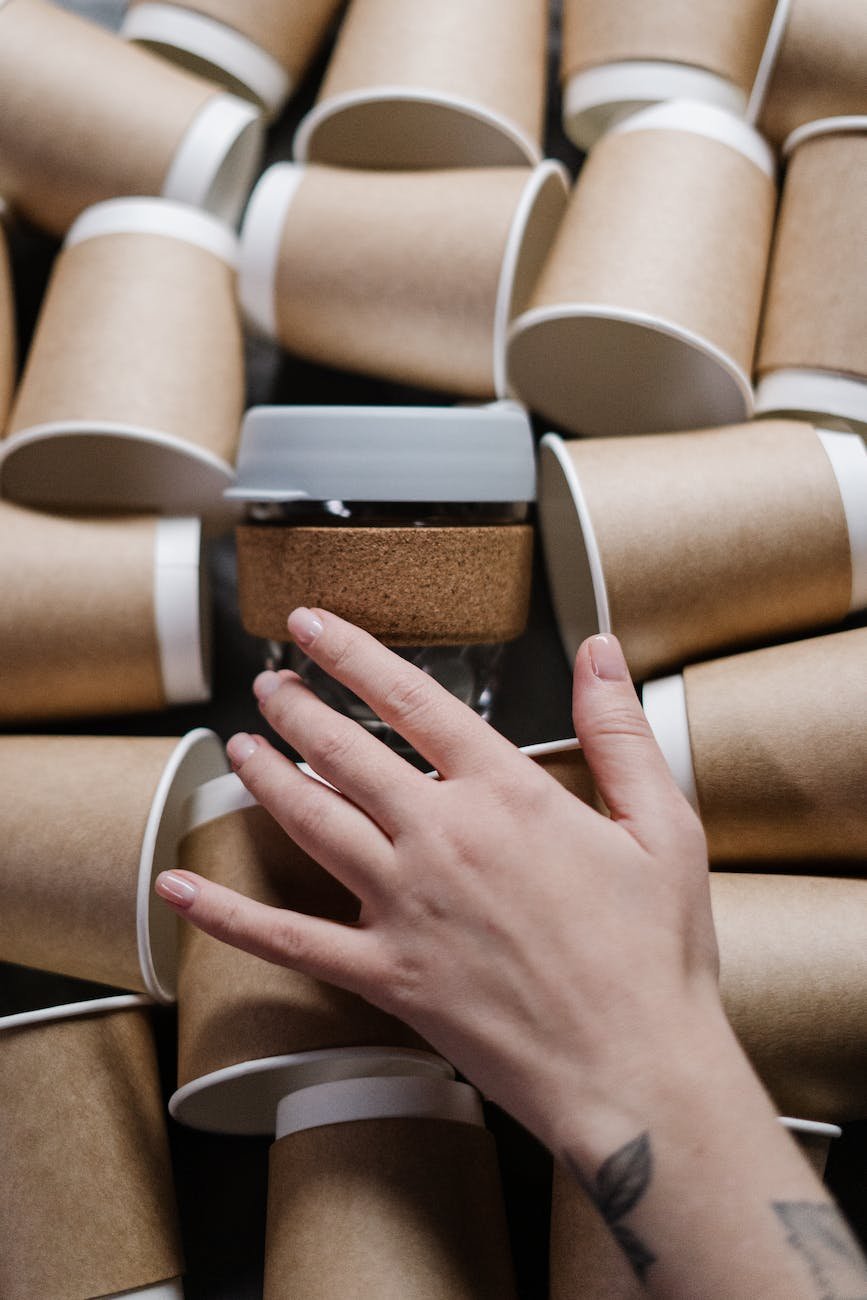In our modern world, the need to reduce our environmental impact is more important than ever. Eco-friendly printing, also known as green printing or using environmentally friendly inks, is not just a trend; it’s a vital step towards a more sustainable future. This comprehensive guide is dedicated to making printing more eco-friendly by providing you with the knowledge, steps, and resources you need to make informed and environmentally friendly printing choices.

Understanding the Impact of Traditional Printing & Printing Techniques
In an age where the eco aspect is no longer a choice but a necessity, understanding the environmental footprint of our day-to-day practices, notably traditional printing, is critical. This process, where practices within environmentally-friendly printing come into action, is a frequent sight in offices, schools, and homes and has been a significant contributor to environmental degradation. To understand why ready to make a shift to eco-friendly printing is crucial, we must first examine the impact on the environment from traditional printing practices.
Excessive Paper Waste and Deforestation
One of the most noticeable environmental impacts of traditional printing comes with the abundant paper waste it generates, highlighting the need to reduce material waste. Every year, millions of tons of paper are used in printing documents, newspapers, magazines, and more, much of which ends up in landfills. This doesn’t just signify a misuse of resources but also contributes notably to landfill mass, creating a detrimental impact on the environment. The demand for paper propels deforestation further, leading to the loss of biodiversity, habitat destruction, and increased carbon emissions due to the reduction of trees that absorb CO2, thereby escalating the impact on the environment.
Water Pollution and Usage
The traditional printing industry also heavily consumes water, highlighting another aspect of eco-friendly practices. Water is used in various stages of paper production and in the printing process itself. Additionally, the industry exacerbates water pollution due to the discharge of contaminated water containing inks, dyes, and other chemicals from paper mills and printing facilities, further increasing the impact on the environment. These pollutants can be harmful to aquatic life and can contaminate drinking water sources, leading to wider ecological and health problems – another aspect of eco-friendly concerns.
Release of Volatile Organic Compounds (VOCs)
Volatile Organic Compounds, or VOCs, are a group of chemicals that vaporize at room temperature and are commonly found in printing inks and solvents. When released into the atmosphere, VOCs create a detrimental impact on the environment, contributing to air pollution and the formation of ground-level ozone, a critical component of smog. Exposure to VOCs can lead to various health issues, including respiratory problems, headaches, and nausea. It also has a broader environmental impact, contributing to the greenhouse effect and global warming.
Carbon Footprint
Traditional printing processes, especially those reliant on outdated technologies, are energy-intensive. The energy employed in manufacturing paper, operating printing equipment, and the transportation of printed materials contributes overwhelmingly to greenhouse gas emissions, underlining the need to take the first step towards eco-friendly printing. This carbon footprint is a critical concern in the fight against climate change, as it adds to the already high levels of CO2 and other greenhouse gases in the atmosphere.
The Use of Hazardous Chemicals
Beyond paper and VOCs, traditional printing involves various chemicals, including bleaches, solvents, and metal-based inks. These substances can be harmful to both humans and the environment. Workers in the printing industry are at risk of exposure to these chemicals, which can lead to health problems. When these chemicals are disposed of improperly, they can leach into soil and water, causing contamination and posing risks to wildlife and ecosystems.
The Call for Sustainable Printing Practices
Understanding the impacts of traditional printing is the first step in mitigating its environmental footprint. The information age has brought with it a heightened awareness of environmental issues and a push towards more sustainable practices in all aspects of life, including printing. By recognizing the adverse effects of traditional printing methods, individuals and businesses are better equipped to make informed decisions and adopt eco-friendly printing practices. These sustainable alternatives not only help in reducing the environmental burden but also pave the way for a more responsible and sustainable future.
As we move forward, it’s not only about reducing the use of paper or switching to digital alternatives; it’s about a comprehensive approach to sustainability. This includes choosing recycled paper, using inks made from natural or non-toxic substances, adopting energy-efficient printing technologies, and embracing digital forms of communication and documentation whenever possible. By understanding the full spectrum of traditional printing’s environmental impact, we can take significant steps towards a more sustainable and environmentally responsible printing industry.

Key Benefits of Eco-Friendly Printing
Transitioning to eco-friendly printing practices isn’t just a moral or environmental imperative; it’s a strategic move that offers a multitude of benefits for individuals, businesses, and society as a whole. By understanding the advantages of adopting green printing methods, organizations can make informed decisions that align with their sustainability goals and operational needs. Here are the key benefits of eco-friendly printing:
1. Significant Reduction in Environmental Impact
Reduce Waste:
Eco-friendly printing practices dramatically decrease the amount of waste produced. By using recycled paper or less paper overall through efficient design, businesses can minimize their waste footprint. Additionally, eco-friendly practices often involve recycling used materials, further reducing the need for new resources and the amount of waste going to landfills.
Lower Emissions of Harmful Substances:
Traditional printing releases volatile organic compounds (VOCs) and other harmful chemicals into the environment. Eco-friendly printing uses soy or vegetable-based inks and fewer chemicals, significantly reducing air and water pollution. This leads to a cleaner, healthier environment and reduces the negative health impacts associated with chemical exposure.
Conservation of Natural Resources:
By opting for recycled or sustainable materials, eco-friendly printing helps conserve vital resources such as trees and water. It also promotes the use of renewable energy in the printing process, further reducing the ecological footprint.
2. Cost Savings
Efficient Resource Use:
Eco-friendly printing methods often require less energy and raw materials, which can translate into cost savings over time. Energy-efficient printers, reduced paper waste, and streamlined processes mean lower operational costs.
Long-Term Savings:
While some eco-friendly options might have a higher upfront cost, they can lead to significant savings in the long run. Reduced waste means lower disposal costs, and sustainable practices can lead to savings on materials as prices for traditional resources rise.
3. Enhanced Brand Image and Market Position
Positive Public Perception:
Consumers are increasingly aware of environmental issues and often prefer to support businesses that demonstrate a commitment to sustainability. By adopting eco-friendly printing, companies can improve their public image and appeal to a broader, more environmentally conscious customer base.
Competitive Advantage:
As sustainability becomes a more critical factor in consumer decisions, eco-friendly practices can be a differentiating factor in the market. Businesses that are early adopters of green printing can establish themselves as industry leaders in sustainability.
4. Compliance and Risk Management
Regulatory Compliance:
Environmental regulations are becoming stricter worldwide. By adopting eco-friendly printing practices, businesses can ensure they meet current and future regulations, avoiding fines and legal issues.
Reduced Risk:
Sustainable practices can mitigate risks associated with resource scarcity, regulatory changes, and volatile prices for traditional materials. By relying on renewable and more stable resources, businesses can ensure a more predictable and secure operational environment.
5. Health and Safety Improvements
Safer Workplace:
Eco-friendly inks and materials are generally less toxic and safer to handle, leading to a healthier workplace. This can reduce health-related costs and improve employee satisfaction and productivity.
Community Health Benefits:
By reducing emissions and pollution, eco-friendly printing contributes to cleaner air and water, benefiting the broader community’s health and well-being.
The transition to eco-friendly printing offers a pathway to environmental stewardship, cost savings, improved brand reputation, and compliance with regulations, all while contributing to the health and well-being of both the planet and its inhabitants. As technology advances and consumer awareness grows, the shift towards sustainable printing practices is not just a trend but a fundamental change in how we think about and manage our printing needs. By embracing eco-friendly printing, businesses and individuals can make a meaningful impact, ensuring a healthier, more sustainable future for all.

Step-by-Step Guide to Adopting Environmentally Friendly Printing
Embracing eco-friendly printing is a commendable decision that reflects your commitment to sustainability. This step-by-step guide will navigate you through the transition to more sustainable printing practices, ensuring you understand the choices and changes necessary for a greener printing approach.
Step 1: Assess Your Current Printing Needs and Practices
Evaluate Your Usage:
Start by assessing how much printing is done in your organization. Understand what, why, and how often you need to print. This will help you identify areas for improvement and potential reductions.
Audit Current Materials and Equipment:
Take stock of the printers, inks, and paper types you currently use. Determine their environmental impact and identify which ones are less eco-friendly.
Step 2: Set Clear, Achievable Goals
Define Objectives:
Set specific, measurable goals for reducing paper use, waste, and the overall environmental impact of your printing. This could include reducing paper usage by a certain percentage or transitioning to 100% recycled paper.
Commit Publicly:
Make a public commitment to eco-friendly practices. This holds your organization accountable and can improve your brand image.
Step 3: Choose Eco-Friendly Inks and Sustainable Printing Materials
Select Sustainable Paper:
Opt for recycled, FSC-certified, or other types of eco-friendly paper that reduce the demand for virgin resources and lower environmental impact.
Use Eco-Friendly Inks:
Switch from traditional petroleum-based inks to vegetable or soy-based inks, which emit fewer VOCs and are easier to remove during recycling.
Step 4: Implement Energy-Efficient Printing Equipment
Upgrade to Energy-Efficient Printers:
Invest in printers that have energy-saving modes, duplex printing, and are ENERGY STAR certified.
Consolidate Printing Stations:
Reduce the number of printers in use by setting up centralized, shared printing stations that are more efficient.
Step 5: Optimize Printing Processes
Implement Print Management Software:
Use software to track and control printing habits, set rules for printing, and encourage responsible use.
Encourage Responsible Printing:
Promote double-sided printing, draft quality for non-essential documents, and digital proofs to reduce unnecessary prints.
Step 6: Embrace Digital Alternatives
Go Paperless Where Possible:
Adopt digital documentation, file sharing, and electronic signatures to reduce the need for physical prints.
Educate and Train Staff:
Ensure your team understands the importance of eco-friendly printing and how they can contribute. Provide training on using digital tools and optimizing print settings.
Step 7: Regularly Review and Improve
Monitor Progress:
Regularly check your printing metrics against your goals to measure success and identify areas for further improvement.
Stay Informed on Innovations:
Keep up with the latest in eco-friendly materials and technology to continuously enhance your sustainable printing practices.
Adopting eco-friendly printing is an ongoing journey of continuous improvement. By following these steps, you can significantly reduce the environmental impact of your printing, save costs in the long run, and position your business or organization as an environmentally responsible leader. Remember, every step towards eco-friendly printing is a step towards a more sustainable future.

Best Practices in Sustainable Printing
Adopting eco-friendly printing practices is a holistic approach that encompasses every aspect of the printing process. It’s about making informed, responsible decisions that reduce waste, save resources, and minimize the environmental impact while maintaining high-quality results. This guide provides essential tips and practices for making your printing process more sustainable, integrating the use of eco-friendly materials, techniques, and strategies to help you and your business contribute to a more sustainable future.
Utilize Eco-Friendly Materials
Choose Recycled or Sustainable Paper:
Opt for paper that has been recycled or sourced from well-managed forests. The use of recycled paper greatly reduces the demand on forests and the amount of paper waste that ends up in landfills.
Select Eco-Friendly Inks:
Switch to inks made from vegetable or soy-based materials. Unlike traditional petroleum-based inks, these eco-friendly inks have lower levels of VOCs, reducing the release of harmful chemicals into the environment.
Reduce Waste
Implement On-Demand Printing:
Only print what you need, when you need it, to minimize waste. On-demand printing eliminates excess copies and reduces the amount of unused printed materials.
Encourage Duplex Printing:
Set your printers to default to double-sided printing to halve the amount of paper used. This simple step can significantly reduce paper consumption and waste.
Optimize Printing Methods
Go Digital Where Possible:
Before printing, consider if digital alternatives can be used. Electronic documents, digital signatures, and online sharing platforms can significantly reduce the need for physical prints.
Use Efficient Printers:
Invest in energy-efficient, eco-friendly printers that are designed to reduce electricity consumption and waste. Look for printers with ENERGY STAR ratings and features like automatic sleep mode.
Educate and Engage Your Team
Promote Awareness:
Educate your team about the importance of eco-friendly printing and the impact of traditional printing methods on the environment. Understanding the environmental impact of printing is crucial in motivating change.
Provide Training:
Offer training sessions on how to use eco-friendly printing options and practices. Ensure everyone knows how to print double-sided, optimize print layouts to use less paper, and recycle used materials properly.
Continuously Improve
Regularly Review Practices:
Continuously assess and improve your printing practices. Stay informed about the latest sustainable printing materials, technologies, and methods to keep improving your environmental performance.
Seek Feedback:
Engage with your team, clients, and suppliers to find new ways to reduce the environmental impact of your printing. Collaborative efforts can lead to innovative solutions and broader adoption of eco-friendly practices.
The journey toward sustainable printing is ongoing and requires a commitment from every level of an organization. By adopting these best practices in sustainable printing, you can reduce waste, conserve resources, and minimize your environmental footprint—all while maintaining quality and efficiency in your printing needs. Remember, each step towards eco-friendly printing is a step towards a more sustainable future. Make the switch today, and be part of the movement for a greener, more responsible world.

Innovations and Future of Eco-Friendly Printing
The path to sustainability is ever-evolving, with new technologies and innovative practices emerging regularly. The printing industry is no exception, experiencing a significant shift towards greener, more sustainable methods. This evolution is driven by the demand for reduced environmental impact and the growing consciousness among consumers and businesses alike. Here’s a closer look at some of the exciting innovations and what the future might hold for eco-friendly printing.
Current Innovations in Eco-Friendly Printing
Vegetable-Based and Soy Inks:
Moving away from traditional petroleum-based inks, the industry has seen a significant rise in the use of vegetable-based and soy inks. These alternatives offer a more sustainable solution, producing fewer volatile organic compounds (VOCs) and making it easier to recycle paper.
Natural Dyes and Mordants:
The use of natural dyes and mordants in textile printing is gaining traction. Derived from plants, minerals, and other natural sources, these substances are less harmful to the environment and are often biodegradable, reducing the chemical impact on the ecosystem.
On-Demand Printing:
On-demand printing has revolutionized the way we think about printing. By printing exactly what is needed, when it’s needed, it significantly reduces waste and inventory costs. This approach not only minimizes excess production but also allows for greater flexibility and customization.
Digital Printing Advancements:
Digital printing technology continues to advance, offering higher quality prints with less energy and material waste. Digital printing doesn’t require plates or other setup materials, reducing the physical and carbon footprint associated with print production.
Future Possibilities of Green Printing
Biodegradable Printing Materials:
Research is ongoing into fully biodegradable and compostable printing materials. These materials break down naturally, reducing landfill waste and offering a closed-loop, cradle-to-cradle solution for print products.
Energy-Efficient Printing Technologies:
As concern over energy consumption grows, the development of more energy-efficient printing technologies is a priority. Future printers are expected to use less energy, have a smaller carbon footprint, and integrate seamlessly with renewable energy sources.
Adoption of Renewable Energy:
Printing facilities are increasingly looking to power their operations with renewable energy. Solar, wind, and other renewable sources can significantly reduce the carbon footprint of printing operations, making the entire process cleaner and more sustainable.
3D Printing of Sustainable Materials:
3D printing offers exciting possibilities for reducing waste through precise material usage and the potential to use recycled or biodegradable filaments. As the technology matures, its application in producing eco-friendly products and components is expected to grow.
Customization and Localization:
Future eco-friendly printing is likely to focus more on localized production and customization, reducing the need for long-distance transportation and the associated emissions. Localized, made-to-order production can significantly reduce environmental impact and promote more sustainable consumption patterns.
The future of printing lies in sustainable practices and technologies. From vegetable-based inks to renewable energy-powered presses, the industry is evolving to meet the demands of an increasingly eco-conscious world. By staying informed and embracing these innovations, businesses and consumers can contribute to a healthier, more sustainable future. As we continue to innovate and improve, eco-friendly printing will become not just an option but the standard for the industry.

Implementing Eco-Friendly Solutions in Your Business
Making your business’s printing practices more environmentally friendly can seem daunting, but with the right approach, it’s entirely achievable. This section offers practical advice and strategies for businesses of all sizes to integrate sustainable printing into their operations effectively. From using natural materials to reduce waste and adopting on-demand printing to minimize excess prints, these strategies are designed to help you make your printing operations gentle on the environment and good for business. Here is a summarized guide to integrating sustainable printing practices effectively:
- Evaluate Your Current Printing Needs:
- Assess current printing habits and needs.
- Identify areas of waste and potential for digitization.
- Set Clear Sustainability Goals:
- Define specific, measurable objectives for eco-friendly printing initiatives.
- Choose Eco-Friendly Printing Materials:
- Paper: Opt for recycled or sustainably sourced paper with certifications like FSC or PEFC.
- Inks: Switch to soy or vegetable-based inks for lower environmental impact.
- Optimize Printing Equipment and Settings:
- Upgrade to modern, energy-efficient printers with ENERGY STAR ratings.
- Configure default settings to double-sided printing and lower quality for drafts.
- Reduce, Reuse, Recycle:
- Implement paperless solutions and digital collaboration tools.
- Establish a recycling program for paper waste and used ink cartridges.
- Encourage Responsible Printing Among Employees:
- Educate and train employees on the environmental impact and best practices.
- Implement policies and reminders to promote responsible printing.
- Monitor, Report, and Improve:
- Regularly track and assess printing-related consumption and waste.
- Stay informed and ready to adopt the latest sustainable printing technologies and practices.
By following these steps, businesses can significantly reduce their printing-related environmental footprint while benefiting from cost savings and improved corporate image. The journey involves continuous assessment and adaptation to the latest eco-friendly innovations and market demands.

Eco-Friendly Printing Success Stories
Across industries, businesses are recognizing the importance of sustainability and taking significant steps to integrate eco-friendly practices into their operations. The world of printing is no exception. Many organizations have made remarkable strides in adopting sustainable printing solutions, demonstrating that environmental responsibility can go hand in hand with business success. Here are a few success stories that showcase the positive impact of eco-friendly printing.
1. Global Publisher Goes Green
A leading international publishing company decided to make a substantial change in its printing processes by switching to 100% post-consumer waste recycled paper for all its publications. They also invested in energy-efficient printing equipment and adopted soy-based inks. The result was a dramatic reduction in their carbon footprint, water usage, and waste production. Their commitment to sustainability not only helped them reduce costs but also strengthened their brand reputation and customer loyalty.
2. Retail Giant Reduces Paper Usage
One of the world’s largest retail chains implemented a company-wide policy to reduce paper waste by encouraging double-sided printing, digitizing internal communications, and using recycled paper for all in-store signage. They also optimized their supply chain to reduce the need for printing and packaging. These initiatives significantly decreased their paper consumption and waste, leading to cost savings and a more streamlined operation.
3. Marketing Firm Embraces Digital Printing
A forward-thinking marketing firm embraced digital printing technology to offer its clients more sustainable printing options. By using advanced digital printers, they were able to provide on-demand printing, reducing overproduction and waste. They also offered a range of eco-friendly paper and ink options, including recycled materials and vegetable-based inks. Their commitment to green printing attracted environmentally conscious clients and set them apart in a competitive market.
4. University Commits to Campus-Wide Sustainability
A prominent university launched a comprehensive program to promote sustainability across its campus, including its printing services. They replaced all printers with energy-efficient models, established strict printing quotas for students and staff, and switched to recycled paper and eco-friendly inks. The program also included educational initiatives to raise awareness about sustainable printing practices. The university significantly reduced its environmental impact and operational costs while fostering a culture of sustainability among students and faculty.
5. Graphic Design Studio Prioritizes Eco-Friendly Materials
A boutique graphic design studio specializing in sustainable design made eco-friendly printing a cornerstone of its business model. They sourced only the most sustainable materials, including organic textiles, recycled paper, and natural dyes. They also worked closely with local, eco-conscious printers to ensure that all their products were produced responsibly. Their dedication to sustainability attracted like-minded clients and helped them build a strong, environmentally responsible brand.
These success stories demonstrate that adopting eco-friendly printing practices is not only good for the environment but also beneficial for business. By making thoughtful choices about materials, technology, and processes, organizations of all sizes can reduce their environmental impact, save costs, and enhance their reputation. As more businesses share their successes and learn from each other, the movement towards sustainable printing will continue to grow, paving the way for a greener, more responsible future.

Navigating Challenges in Eco-Friendly Printing
While the shift towards eco-friendly printing is a positive and necessary move for any organization, it’s not without its challenges. Understanding these obstacles and how to navigate them is crucial for a successful transition. Here are some common challenges faced in eco-friendly printing and practical strategies to overcome them.
Challenge 1: Finding the Right Sustainable Materials
Problem:
One of the first hurdles many businesses encounter is the difficulty in sourcing high-quality, sustainable printing materials that meet their needs. The market for eco-friendly paper, inks, and other supplies is vast and can be overwhelming.
Solution:
- Research and Partner Up: Take the time to research and identify suppliers who specialize in eco-friendly materials. Look for certifications and standards that assure the sustainability and quality of their products.
- Request Samples: Before making a bulk purchase, request samples to test the quality and suitability of the eco-friendly materials for your specific printing needs.
Challenge 2: Higher Costs of Green Materials
Problem:
Eco-friendly materials can often come at a higher price point compared to conventional alternatives, which can be a deterrent for businesses, especially small to medium-sized ones.
Solution:
- Calculate Long-Term Savings: Consider the long-term cost savings that come from reduced waste and energy consumption. Investing in eco-friendly materials can lead to significant savings over time.
- Explore Bulk Buying or Co-ops: Look into bulk purchasing options or join a cooperative to get sustainable materials at a lower cost.
Challenge 3: Resistance to Change
Problem:
Changing long-established printing methods and habits can meet resistance from employees or management accustomed to traditional practices.
Solution:
- Educate and Engage: Provide training and information sessions about the benefits and necessity of eco-friendly printing. Highlighting the positive environmental impact and potential cost savings can help build support for the change.
- Start Small and Showcase Success: Implement changes gradually and share the positive outcomes and savings from early wins to build momentum and support.
Challenge 4: Maintaining Quality and Performance
Problem:
Some organizations worry that switching to eco-friendly printing materials might result in lower quality or performance issues.
Solution:
- Quality Assurance: Work with reputable suppliers known for their high-quality eco-friendly products. Conduct trials to ensure the materials meet your quality standards before fully transitioning.
- Stay Updated on Technologies: Keep abreast of the latest developments in eco-friendly printing technologies in Qatar that continually improve quality and performance.
Challenge 5: Integrating New Technologies
Problem:
Adopting new, more sustainable printing technologies can be daunting and requires an initial investment.
Solution:
- Plan for Gradual Implementation: Develop a phased approach to integrate new technologies, allowing time for staff training and adjustment.
- Seek Financial Incentives: Look for government or industry grants, tax incentives, or other financial assistance programs designed to support businesses adopting sustainable technologies.
Challenge 6: Ensuring a Consistent Supply
Problem:
Consistently sourcing eco-friendly materials can sometimes be challenging, especially for businesses in regions with limited suppliers.
Solution:
- Diversify Suppliers: Don’t rely on a single supplier for your materials. Establish relationships with multiple providers to ensure a consistent supply chain.
- Local Sourcing: Whenever possible, source materials locally to reduce transportation emissions and support your local economy.
Transitioning to eco-friendly printing is a journey filled with challenges, but with the right approach and mindset, these obstacles can be overcome. By staying informed, planning carefully, and engaging your team, you can ensure a smooth transition to more sustainable printing practices. Remember, each challenge overcome is a step towards a more sustainable and responsible business operation.

Towards a Sustainable Future: The Final Word
As we reach the end of our comprehensive journey through eco-friendly printing, it’s clear that our collective commitment to sustainable practices is more crucial than ever. Engaging in continuous improvement and innovation is not just an option but a responsibility we all share for a sustainable future. Now is the time for action, and every step you take makes a significant difference. If you’re ready to embrace eco-friendly practices and contribute to a greener world, explore a wide range of eco-friendly products at Brandscape.
Visit Brandscape’s Eco-Friendly Collection to find all you need for sustainable living and business operations right here in Qatar. Together, let’s make a commitment to sustainability and transform our world, one print at a time.

FAQs
Below are some frequently asked questions about eco-friendly printing, incorporating the provided keywords to ensure a comprehensive and informative guide.
Q1: What is eco-friendly printing, and how does it differ from traditional printing?
Eco-friendly printing involves practices that reduce the environmental impact of printing. Unlike traditional printing, which often uses high amounts of paper and toxic inks, eco-friendly printing uses sustainable printing practices, including recycled paper, vegetable-based inks, and energy-efficient printers to minimize waste and reduce the release of harmful chemicals like volatile organic compounds (VOCs).
Q2: How can adopting eco-friendly printing contribute to a sustainable future?
Adopting eco-friendly printing reduces the environmental impact of paper production and waste, conserves energy, and minimizes the use of harmful substances. By using sustainable materials and eco-friendly practices, businesses and individuals can contribute to a sustainable future by reducing their carbon footprint and supporting a healthier planet.
Q3: What are some effective ways to reduce waste in printing?
To reduce waste, consider on-demand printing to avoid excess prints, use double-sided printing to save paper, and opt for digital proofs. Implement eco-friendly printing practices like recycling ink cartridges and using recyclable fabric or paper. Employing these printing tips can significantly decrease the amount of paper and materials used, leading to less landfill waste.
Q4: What are some eco-friendly alternatives for printing inks and materials?
Eco-friendly inks such as soy-based or vegetable-based inks are excellent alternatives to traditional solvent inks. For materials, opt for recycled or FSC-certified paper, natural dyes, and mordant for textiles. These sustainable printing materials are less harmful to the environment and often offer vibrant colors while being gentle on the environment.
Q5: How can I ensure the printing methods I use are environmentally friendly?
To ensure your printing methods are environmentally friendly, choose eco-friendly printers that are energy-efficient and support duplex printing. Adopt green printing techniques like using digital or on-demand printing which eliminates the need for large print runs and reduces waste. Always look for sustainable alternatives and printing options that reduce energy consumption and material waste.
Q6: How does using recycled paper make printing more eco-friendly?
Using recycled paper helps make printing more eco-friendly by reducing the need for new raw materials, thus saving trees and decreasing energy usage in paper production. It also lessens paper waste going to landfills and supports the recycling industry, making it a responsible and sustainable choice for printing.
Q7: How can businesses benefit from going green with their printing?
Businesses can benefit from going green with their printing by reducing costs associated with waste, enhancing their brand image as a company committed to sustainability, and potentially attracting more customers who value environmental responsibility. Eco-friendly printing can also improve workplace health by reducing exposure to VOCs and other harmful chemicals used in traditional printing processes.
Q8: What steps can I take to start adopting eco-friendly printing in my organization?
To start adopting eco-friendly printing, follow a step-by-step guide to assess your current printing needs, set sustainability goals, choose eco-friendly materials and printers, optimize printing settings, and educate your team about sustainable practices. Continuously monitor progress and stay updated on new eco-friendly options and technologies available in the market.
Q9: What role does renewable energy play in eco-friendly printing?
Renewable energy plays a crucial role in eco-friendly printing by powering printing operations with clean, sustainable energy sources like solar or wind. This reduces the carbon footprint associated with printing and supports a more sustainable approach to printing, contributing to a healthier environment.
Q10: How important is it for consumers and businesses to commit to eco-friendly printing practices today?
It’s more important than ever for both consumers and businesses to commit to eco-friendly printing practices. As the global focus on sustainability grows, adopting green printing solutions is vital to reducing our environmental impact, conserving natural resources, and ensuring a sustainable future. By making informed printing choices and showing a commitment to sustainability, individuals and organizations can make a significant positive impact.


Leave a Reply